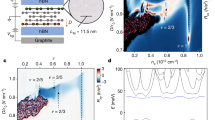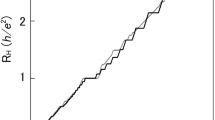Abstract
In the fractional quantum Hall effect regime, the diagonal (ρxx) and Hall (ρxy) magnetoresistivity tensor components of the two-dimensional electron system (2DES) in gated GaAs/AlxGa1−x As heterojunctions are measured together with the capacitance between 2DES and the gate. The 1/3-and 2/3-fractional quantum Hall effects are observed at rather low magnetic fields where the corresponding fractional minima in the thermodynamic density of the states have already disappeared, thus, implying the suppression of the quasiparticle energy gaps.
Similar content being viewed by others
References
The Quantum Hall Effect, Ed. by R. Prange and S. M. Girvin (Springer, New York, 1987; Mir, Moscow, 1989).
R. B. Laughlin, Phys. Rev. B 23, 5632 (1981).
D. E. Khmel’nitskiĭ, Pis’ma Zh. Éksp. Teor. Fiz. 38, 454 (1983) [JETP Lett. 38, 552 (1983)]; Phys. Lett. A 106A, 182 (1984); Helv. Phys. Acta 65, 164 (1992).
Bodo Huckestein, Phys. Rev. Lett. 84, 3141 (2000).
S. S. Murzin, A. G. M. Jansen, and P. von der Linden, Phys. Rev. Lett. 80, 2681 (1998); S. S. Murzin, A. G. M. Jansen, and I. Claus, Phys. Rev. Lett. 92, 016802 (2004).
A. M. M. Pruisken, in The Quantum Hall Effect, Ed. by R. Prange and S. M. Girvin (Springer, New York, 1987; Mir, Moscow, 1989).
C. A. Lütken and G. G. Ross, Phys. Rev. B 45, 11 837 (1992); Phys. Rev. B 48, 2500 (1993).
B. P. Dolan, Nucl. Phys. B 554, 487 (1999); J. Phys. A 32, L243 (1999).
C. P. Burgess and B. P. Dolan, Phys. Rev. B 63, 155309 (2001).
A. M. M. Pruisken, M. A. Baranov, and B. Škorić, Phys. Rev. B 60, 16 807 (1999).
T. P. Smith, B. B. Goldberg, P. J. Stiles, and M. Heiblum, Phys. Rev. B 32, 2696 (1985).
B. I. Halperin, Helv. Phys. Acta 56, 75 (1983).
J. P. Eisenstein, L. N. Pfeiffer, and K. W. West, Phys. Rev. Lett. 68, 674 (1992); Phys. Rev. B 50, 1760 (1994).
S. I. Dorozhkin, R. J. Haug, K. von Klitzing, and K. Ploog, Phys. Rev. B 51, 14 729 (1995).
S. I. Dorozhkin, A. A. Shashkin, N. B. Zhitenev, and V. T. Dolgopolov, Pis’ma Zh. Éksp. Teor. Fiz. 44, 189 (1986) [JETP Lett. 44, 241 (1986)].
G. S. Boebinger, H. L. Stormer, D. C. Tsui, et al., Phys. Rev. B 36, 7919 (1987).
Xin Wan, D. N. Sheng, E. H. Rezayi, et al., Phys. Rev. B 72, 075325 (2005).
F. G. Pikus and A. L. Efros, Phys. Rev. B 47, 16 395 (1993).
J. K. Jain, Phys. Rev. Lett. 63, 199 (1989).
C. P. Burgess, R. Dib, and B. P. Dolan, Phys. Rev. B 62, 15359 (2000).
S. Kivelson, D. H. Lee, and S. C. Zhang, Phys. Rev. B 46, 2223 (1992).
Taking into account the complicated spin behavior of the QHE state at v = 2/3 (see Ref. [25] as the early observation and Ref. [26] for the recent progress) one may expect deviation of the real boundary from the theoretical semicircle centered at σxy = 5/8 (see Fig. 4). However, our previous study of the spin effects in sample 1 revealed complete spin polarization at v appreciably smaller 2/3 in rather high magnetic fields [27] and did not indicate depolarization at v ≈ 2/3 for the range of magnetic fields studied here. This observation and agreement between flow lines experimentally measured for this sample in Ref. [28] and theoretical ones [8, 22] justify comparison with the theory provided in Fig. 4 at least for σxy smaller and around 5/8, where conductivity trace is expected to touch the boundary.
J. P. Eisenstein, H. L. Stormer, L. N. Pfeiffer, and K. W. West, Phys. Rev. B 41, 7910 (1990).
J. H. Smet, R. A. Deutschmann, F. Ertl, et al., Nature 415, 281 (2002).
S. I. Dorozhkin, M. O. Dorokhova, R. J. Haug, and K. Ploog, Phys. Rev. B 55, 4089 (1997).
S. S. Murzin, S. I. Dorozhkin, D. K. Maude, and A. G. M. Jansen, Phys. Rev. B 72, 195317 (2005).
Author information
Authors and Affiliations
Additional information
The text was submitted by the authors in English.
Rights and permissions
About this article
Cite this article
Murzin, S.S., Dorozhkin, S.I., Tsydynzhapov, G.E. et al. Fractional quantum Hall effect at a suppressed energy gap. Jetp Lett. 86, 139–143 (2007). https://doi.org/10.1134/S0021364007140159
Received:
Issue Date:
DOI: https://doi.org/10.1134/S0021364007140159




